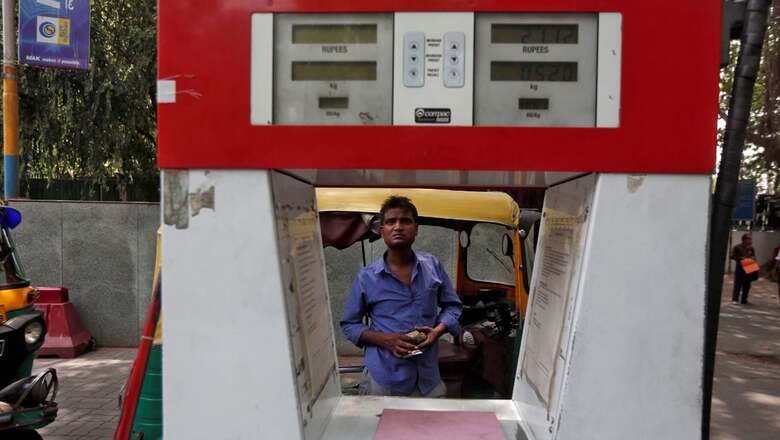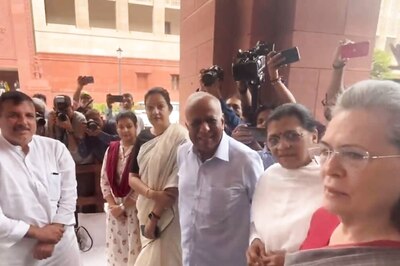
views
The Union Cabinet approved a new formula for determining the price of natural gas, and placed a cap or ceiling price to decrease the prices of CNG and piped cooking gas by as much as 10 per cent.
Announcing the changes, Union I&B Miniser Anurag Thakur at a Cabinet brifeing said, natural gas produced from legacy or old fields, known as APM gas, will now be indexed to the price of imported crude oil instead of benchmarking it to gas prices in four surplus nations such as the US, Canada and Russia.
APM gas will be priced at 10 per cent of the price of the Indian basket of crude oil imported by India. However, the rate will be limited to a maximum of USD 6.5 per million British thermal units, and there will also be a minimum or base price of USD 4 per mmBtu.
The ceiling price is lower than the current rate of USD 8.57 per mmBtu and would translate into a reduction in prices of piped cooking gas as well as CNG sold to automobiles, Thakur said.
Piped cooking gas prices will be cut by up to 10 per cent across cities while CNG will see a little lower reduction, he added.
Piped cooking gas (PNG) and compressed natural gas (CNG) prices have surged by 80% from August 2021 to August 2022 due following a rise in international energy prices.
CNG Prices in Delhi, Mumbai
Following the decision, the CNG price in Delhi will be cut from Rs 79.56 per kg to Rs 73.59 and that of PNG from Rs 53.59 per thousand cubic meters to Rs 47.59. In Mumbai, CNG will cost Rs 79 per kg instead of Rs 87 and PNG will cost Rs 49 per scm instead of Rs 54.
At present, the Indian basket of crude oil is valued at USD 85 per barrel, which means that 10% of this would amount to a price of USD 8.5. However, due to the imposed cap, APM gas producers such as ONGC and Oil India Ltd will only receive USD 6.5 per mmBtu.
The minister further said these ceiling and base prices will remain in effect for a period of two years, and thereafter, the rates will increase by USD 0.25 per mmBtu annually.
The revision of the natural gas pricing formula is in accordance with the suggestions made by a committee led by Kirit Parikh. Although the committee’s proposal for a base price, ceiling price, and indexation has been approved, the suggestions regarding yearly increment and complete deregulation have been altered.
The panel had suggested a 50 cents per mmBtu increase in the USD 6.50 ceiling every year to slowly move toward the marketing and pricing freedom for APM fields.
Asked about the deregulation, Oil Secretary Pankaj Jain said he cabinet’s decisions were made based on informed judgments.
Rates to be Fixed Every Month
Additionally, the pricing rates will now be set monthly instead of the current practice of bi-annual adjustments.
Presently, the government sets the prices of domestically produced natural gas twice a year. This gas is then utilised to produce CNG for automobiles, piped into households for cooking purposes, and utilized for electricity generation and fertilizer production.
The pricing rates for natural gas produced from legacy or old fields of national oil companies such as Oil and Natural Gas Corporation (ONGC) and Oil India Ltd (OIL) are determined by two different formulas than that used for newer fields situated in challenging-to-reach locations like deep-sea areas.
Ukraine Conflict’s Effect on Oil Prices
The recent surge in global energy prices following Russia’s invasion of Ukraine has caused the prices of domestically produced natural gas to reach record levels. As of March 31, the rates for gas from legacy or old fields stood at USD 8.57 per million British thermal units, while gas from difficult-to-reach fields was priced at USD 12.46 per mmBtu during the six-month period ending March 31.
During the April 1 revision, the pricing of APM gas was put on hold until the Cabinet gave its approval for the new pricing formula. If the old formula had been used, the prices of gas from legacy fields would have increased to USD 10.7 per mmBtu.
The price of gas from difficult fields was cut to USD 12.11 per mmBtu.
Kirit Parikh Committee Recommendations
In an effort to promote India’s transition into a gas-based economy while considering the interests of local consumers and producers, the government formed a committee led by Kirit Parikh last year to review a revision in gas prices.
The committee recommended keeping the formula for determining prices of gas from difficult fields unchanged. However, it suggested introducing a price band for the current production of gas from legacy or old fields, which accounts for two-thirds of the country’s total gas production and is currently subject to the administered price mechanism (APM) until prices are fully deregulated in 2027.
The panel suggested a 50 cents per mmBtu increase in the USD 6.50 ceiling every year to slowly move toward the marketing and pricing freedom for APM fields.
Thakur said the ceiling price takes into account the production costs of gas producers while also providing protection to consumers such as those using CNG, piped cooking gas, and fertilizer plants who have been struggling with high input costs.
APM gas makes up for most of CNG and kitchen gas supplies.
India’s Target to Become Gas-based Economy
India has set a target to increase the share of natural gas in its primary energy mix from the current level of around 6.3 per cent to 15 per cent by 2030, as it aims to become a gas-based economy.
The APM gas fields, which were allotted to ONGC and OIL before 1999, do not involve profit-sharing with the government. The pricing formula for gas produced from these fields is based on the weighted average price of gas at international gas hubs in surplus nations and is revised every six months. The last revision was made on October 1, and the next revision is due on April 1.
The Kirit Parikh committee recommended a 20% premium over APM prices for ONGC and OIL to incentivise additional production from new wells or well interventions in the nomination blocks until complete freedom. This recommendation has been approved by the Cabinet, according to Thakur.
As much as 34 per cent of APM gas is allotted to the power sector in 2021-22, 17 per cent to the fertilizer industry, which impacts food prices, and 22 per cent to the city gas sector.
The committee also recommended that gas should be brought under the Goods and Services Tax, or GST, regime. Having a common taxation such as GST for gas in lieu of state level VATs, which vary from 3 per cent to as high as 24 per cent, will help develop the market.
(With inputs from PTI)
Read all the Latest Business News here



















Comments
0 comment